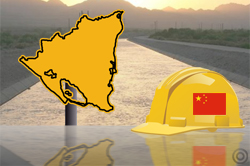Behind a Nicaraguan super-canal: China
Monday, March 24, 2014

Work will start this year on a project to connect the Atlantic and Pacific oceans through Nicaragua, President Daniel Ortega said a few weeks ago.
Given the technical difficulties involved, along with the financial and environmental risk, it’s hard to imagine that a Nicaraguan super-canal will be built.
On the other hand, Beijing may support a project, which gives it a strategic beachhead in the Americas, and which could be a major link for shipping between Asia and North and South America during the 21st Century.
As for one of the poorest countries in the world, the benefits may be worth the risks.
Given the obstacles involved, there are reasons to doubt Ortega’s prediction, to the effect that construction will soon start on a Nicaraguan super-canal.
The project reportedly would cost $40 billion, a figure for which no one has provided any justification, since the concept was announced, over a year ago.
Even if the data is accurate, it remains a mystery as to who would invest in a concession run by an unknown company, Hong Kong Nicaragua Development.
HKND is a subsidiary of Beijing-based Xinwei Telecom Technology, in turn an unlikely leader for a project as complex as the proposed canal, given the company’s modest revenues, and limited experience in logistics.
To serve the big cargo ships of the 21st century, a Nicaraguan canal would need locks of a size never before built – at least a third longer and wider than those of the expanded Panama Canal.
The locks would in addition have to lift ships to new heights.
Lake Nicaragua, through which the route would go, is 33 meters above sea level - seven meters more than Lake Gatun, the highest point of the Panama Canal.
At the same time, there is a player with virtually unlimited amounts of money and skill, which might want to take part in the deal, directly or indirectly.
By supporting the project, China would have a strategic position in the heart of the Americas, at a moment when the United States, together with several Asian countries, opposes Beijing’s claim to potential oil-gas deposits under the South China Sea.
The Nicaraguan project, in addition, may make economic sense.
A new Central American canal would be the shortest route for big ships traveling between Asia and the east coast of the Americas.
The distance between Hong Kong and either New York or Sao Paulo is 17,500 kilometers, using a Central American passage, compared to 19,200 kilometers through Suez.
In addition, the Suez route passes through the Malacca Strait in Southeast Asia, as well as the Red Sea, both of which have piracy problems.
Apart from Suez, the only other route between Asia and the coast of Brazil involves going around South Africa, with an additional distance of a thousand kilometers.
A Nicaraguan canal, with locks more than 400 meters long and 60 meters wide, would accommodate the freighters of the future.
South Korean shipyards are currently building four Triple-E-Class vessels, each of which can carry 18,000 so-called TEUs – twenty-foot-equivalent containers.
Six sister ships are already in service, none of which can fit in the Panama Canal, including an expanded section, due to start operating next year.
For their part, Nicaraguans may not have spent much time calculating the potential income from the canal, compared to the economic benefits, which they would get from leaving untouched large areas of pristine jungle and wetlands.
Then there is the issue of Lake Nicaragua, which has an average depth of 13 meters, and which would need constant dredging, with potential impact on the drinking water of local communities, along with fisheries.
A Triple-E ship needs at least 15 meters of water, if is not to run aground.
On the other hand, Nicaraguans, the poorest people in Latin America, last July approved a project that promises to give them a share of the profits, which is worth 10% after the first ten years, and which would rise by a tenth in each successive decade.
By comparison, the Panama Canal is highly profitable, with net income in 2012 equal to no less than half of gross revenues of $2.5 billion.
The prospect of a Nicaraguan canal is still distant.
But compared to a year ago, the distance looks shorter.
